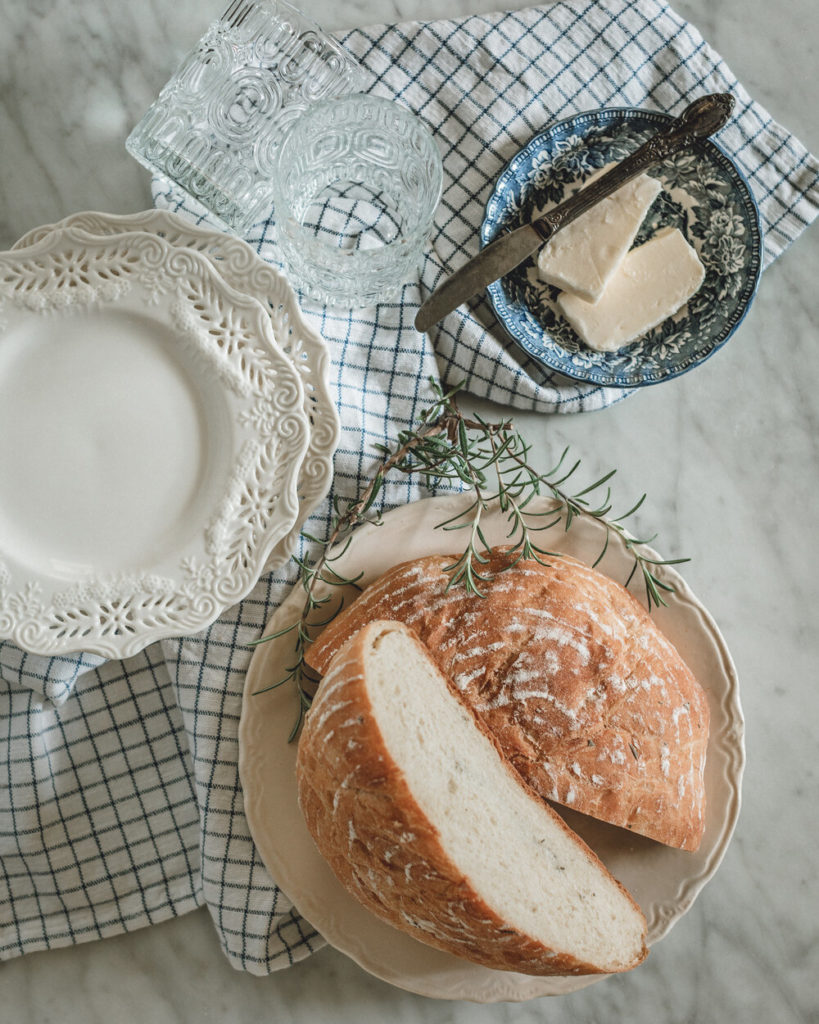Bread doesn’t need to be complicated… This recipe is living proof that anyone can bake bread. Even those of us who believe we never acquired the baking “gene”. The original recipe for this loaf of bread came from Life As a Strawberry, and I’ve been too excited by its sheer ease and forgiving nature, not to share my adapted version with you!

My first crack at bread was with sourdough and, while it worked out fine for me, I don’t recommend it as a starting point. Baking can be intimidating if you’re used to throwing a meal together the way you throw your gym bag in the back of your car… but this recipe is, truly, that easy. No weighing; no worries. Just stick to the recipe and you’ll finish up with a nice golden loaf of bread, and a new party trick!
For this recipe, you’ll need the ingredients listed below, a dutch oven, parchment paper, and a spray bottle. If you don’t have a dutch oven, an alternative is to use a pizza/baking stone and a roasting pan lid. If you use this method, everything remains the same except that you’ll transfer your loaf directly onto the stone in the oven, mist it with water, and cover it with the roasting pan lid for the first 30 minutes of baking (you’ll still need to preheat the lid in the oven). This recipe also includes the use of a proofing basket, which I highly recommend if you plan on baking more bread going forward! But, if you aren’t in possession of one of these lovely devices, you can use a medium-size bowl. Just make sure to flour it enough so the loaf doesn’t stick.
Finally, if you need some visual assistance with the folding or any other aspect of this recipe, you can check out my IGTV video that shows each step of the process!
Simple Rosemary Bread
Ingredients
- 2 1/4 tsp Active Dry Yeast
- 1 tsp Sugar
- 1 1/4 Cups Warm Water
- 1 1/2 tsp Kosher Salt
- 2 1/2 Cups Flour
- 1-2 tsp Chopped Rosemary
Instructions
- In a medium-size bowl, add the active dry yeast, sugar, and warm water. The water should be fairly warm in order to activate the yeast, but not hot. Stir to combine and allow to rest for about 5 minutes. Once the yeast activates, it should rise to the surface, leaving a layer of froth across the top of the water.
- Mix the salt into the water and add the flour in stages, avoiding over-mixing. Once the ingredients are combined and the dough is one solid mass, remove it and dust the bowl generously with flour. Return the dough to the bowl, dusting it one last time before covering it with a tea towel and setting it aside to rise for 1 hour.
- Note: If your home is drafty, the dough may take slightly longer to rise. If possible, try to find a warm location for it to remain until the hour is up. Once the first rise is complete, it should be considerably larger.
- Dust a wooden cutting board or a clean work surface with flour. At this point, if the dough is fairly sticky and difficult to handle, dampen your hands to reduce sticking. Transfer the dough to your work surface, and sprinkle it with a little bit of flour and roughly half of the rosemary.
- Note: To keep some of the loafs lovely air-bubbles, make sure not to push too hard when folding the dough in the next step.
- One side at a time, gently stretch the dough away from its centre, before folding it over itself and gently pressing it into the middle of the mass. Repeat the folding process all the way around, adding the remaining rosemary after about 4 or 5 folds, then continuing until the loaf has begun to smoothen and take shape. The dough will stiffen as you work it, so you want to try to get it as circular as possible before it begins to lose its stretch.
- Flip the dough over and, using both hands, spin it slightly in one direction, while tucking the sides underneath itself. This will shape the dough into a nice ball. Then, generously flour a proofing basket (or medium-sized bowl), place the loaf folded side down, cover it with a tea-towel, and allow it to rise for another 30 minutes.
- Meanwhile, preheat your oven to 460ºF, and place a dutch oven inside.
- Cut a large enough piece of parchment paper to line your dutch oven; bottom and sides (it’s okay if it sticks out slightly from under the lid).
- Once the last rise is complete, very carefully flip the loaf from the proofing basket onto the centre of the parchment paper. Remove the dutch oven from the heat and carefully lower the loaf inside. Using a spray bottle, mist the loaf a few times and quickly cover it with the lid to trap the moisture.
- Bake, covered, for 30 minutes, then remove the lid and continue baking for about 10 minutes, or until deep golden brown. Once finished, carefully remove the loaf and check that it’s finished by knocking on the bottom as if knocking on a door. If it sounds hollow, you’re all set!
- Let it cool completely and enjoy!
Leave a Reply